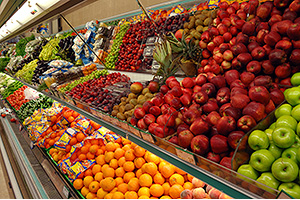Quick Tips: Adding Fruits and Vegetables to Your Diet
Get started
Eating more fruits and vegetables is a great way to improve your nutrition. It can be as easy as adding fruit to a bowl of cereal or adding grated carrots and zucchini to pasta sauce. These tips can help you get started.

Make it easy
- Keep a bowl of fruitwithin easy reach on the kitchen counter or your desk at work so that you can grab a piece of fruit when you’re hungry.
- Buy packaged, ready-to-eat fresh vegetables and fruits. These cut down on preparation time.
- Keep dried fruit on handfor a snack that is easy to take with you when you’re away from home.
- Use the microwave to quickly cook vegetables.
Pump up the flavor
- Dip raw vegetables in low-fat salad dressing, hummus, or peanut butter.
- Toss raw or cooked broccoli and cauliflower with low-fat Italian dressing and Parmesan cheese to make a flavorful side dish.
- Roast vegetables and fruits to bring out their flavor. Just drizzle them with a small amount of olive oil, and bake them in the oven until they are tender.
- Season cooked vegetables with lemon juice and a small amount of olive oil. For extra flavor, add fresh herbs such as basil, tarragon, and sage.
- Try baked apples or pears topped with cinnamon and honey for a delicious dessert.
Stay focused
- Keep track of how many fruits and vegetables you eat each day. You are more likely to eat more fruits and vegetables if you write down how many servings you get.
- Have a goal. Start with small goals you can achieve easily. Then set larger goals as you go. For example, you might want to start by eating one extra serving of fruit or vegetables a day. When you have achieved that goal, your next goal could be to include an extra serving of fruit or vegetables at most meals.
Take small steps
- Mix sliced fruit or frozen berries with yogurt or cereal.
- Add apple chunks, pineapple, grapes, or raisins to tuna or chicken salad.
- Make fruit smoothies by blending together fresh or frozen fruit, fruit juice, and yogurt.
- Add dried or fresh fruit to oatmeal, pancakes, and waffles.
- Add lots of colorful vegetables, such as red cabbage, carrots, and bell peppers, to green salads.
- Top salads with dried cranberries or raisins, or with sliced pears, oranges, nectarines, strawberries, or grapefruit.
- Add extra vegetables, such as grated zucchini or carrots, spinach, kale, and bell peppers, to pasta sauces and soups.
- Add lots of vegetables to sandwiches. Lettuce, tomatoes, cucumbers, bell peppers, and avocado slices are flavorful choices.
Current as of: November 7, 2018
Author: Healthwise Staff
Medical Review:Adam Husney, MD – Family Medicine & Martin J. Gabica, MD – Family Medicine & Kathleen Romito, MD – Family Medicine & Rhonda O’Brien, MS, RD, CDE – Certified Diabetes Educator
Topic Contents
This information does not replace the advice of a doctor. Healthwise, Incorporated, disclaims any warranty or liability for your use of this information. Your use of this information means that you agree to the Terms of Use. Learn how we develop our content.

